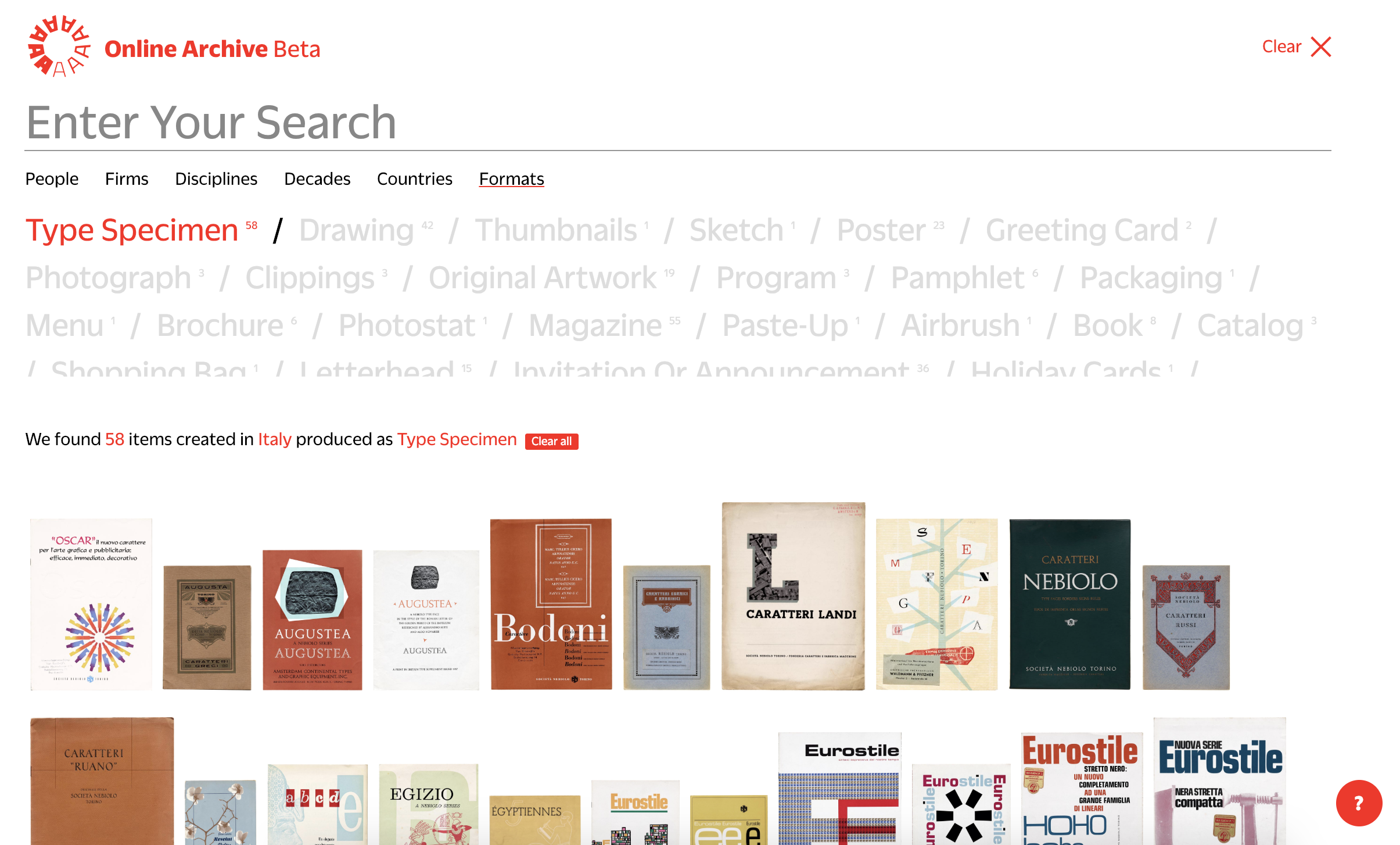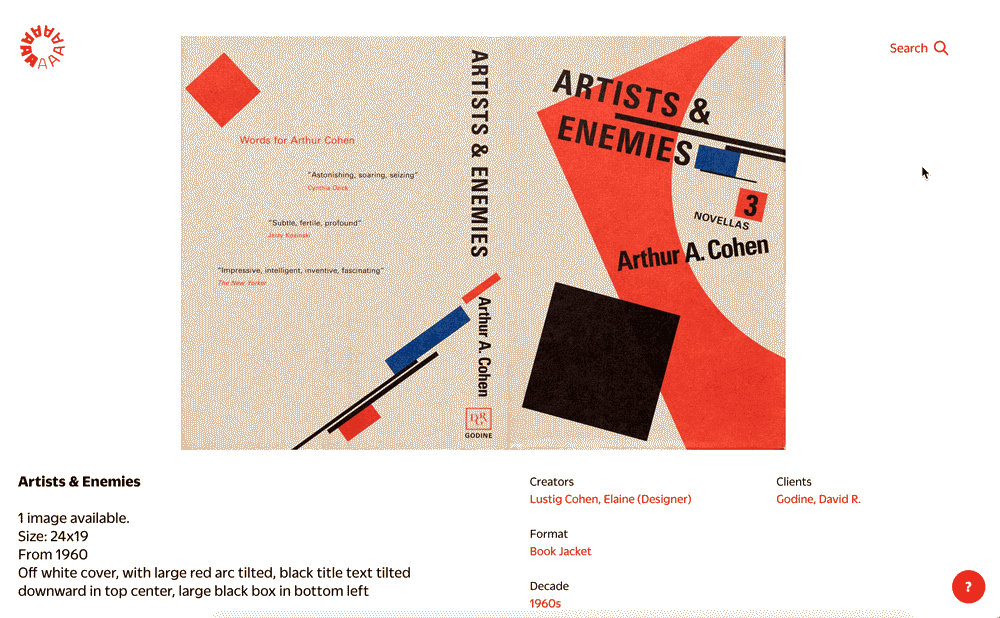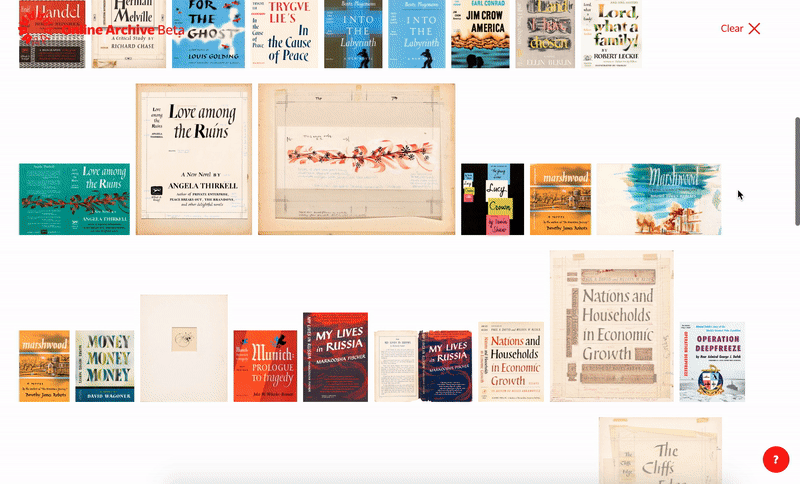News
The Online Archive: Describing Design
Established library vocabularies aren’t right for our unique collection of type, lettering, and graphic design. So we’re creating a new one.

Two weeks ago we launched a beta version of our new Online Archive as a preview for members. The most obvious feature of the site is the big, beautiful imagery. Yet we are equally proud of the data behind those images. It’s the information that fuels the powerful search and filter functions of the site, and it’s written specifically with graphic designers in mind. This first phase of the site surfaces just a small percentage of the metadata we’ve collected, with more to be revealed as the project develops.
Letterform Archive’s catalog project began nearly two years ago, led by Librarian Amelia Grounds and Assistant Librarian Kate Long. Their challenge: draw on their existing library services knowledge, but rethink standards and terminology for the material and audience unique to the Archive.
“Graphic design falls between several disciplines,” explained Amelia, referring to work that is most commonly cataloged by museums of fine art and architecture. “The words designers use to describe processes and materials are different than the words artists and architects use.”
“The words designers use to describe processes and materials are different than the words artists and architects use.”

“For example, Getty’s Art and Architecture thesaurus uses ‘mid-century modernist’ as a term to describe architectural, interior and product design style — none of these cover graphic design,” Amelia said. Although the Archive’s audience spans many creative fields, we primarily serve graphic designers, who widely use the term “mid-century modern” to describe a particular movement of commercial art from the 1940s–60s, epitomized by designers like Saul Bass, Elaine Lustig Cohen, and Herbert Matter.
“It’s worth remembering that being a librarian is, at a high level, the attempt to organize and classify all the knowledge in the universe, so it’s completely expected that there’s a need for specialized vocabularies in libraries that focus on a particular scope,” Amelia said.
So, creating a vocabulary for a collection of graphic design required the librarians to build on existing standards and adjust where those standards don’t meet our needs. Kate describes an epiphany moment from the spring of 2017.
“I was trying to find proper vocabularies for describing posters and kept feeling like the existing thesauruses for graphic materials or art and architecture really skewed either to photographs or fine art. Using the available tools, I could have described a painting or silver gelatin print with near perfect accuracy, but I couldn’t quite describe posters in a way that would be meaningful to our audience. That’s when I knew for sure we’d have to build something out. The last thing we wanted to do was use a vocabulary that wouldn’t describe our materials with terms our audience would use just because it was established. It seemed a bit backwards to build an online resource with rich data that didn’t mean anything to our users. We want to create an intuitive experience for designers — not teach them a new lexicon.”
“We want to create an intuitive experience for designers — not teach them a new lexicon.”

Something else that makes our cataloging and description unique is our non-traditional stance on describing archival material. For collections like Emigre’s or Grushkin’s that include process work as well as final printed material, we do our best to describe the archives at item level instead of at the box or folder level. “This allows us to link related items with unique metadata and show process stories from sketch to final through our Online Archive,” Kate said. “It’s especially important for serving remote research needs as we continue to digitize the collections.”
It’s also key to focus on the aspects of each object that are of most interest to designers. “The structure for many of our materials is more or less a VRA Core model, but we have had to fiddle with that a little,” Kate said. “For books, we want to show who designed the cover or layout or set the type, but in traditional cataloging, you’ll pull the author first.”
“Cataloging is a challenge. Full stop,” added Amelia. “There will always be objects that don’t quite fit the mold and you have to do your best to describe it accurately and with attention to how it fits with other items you’ve already cataloged. As Kate said, our main challenge was trying to build out a standard spreadsheet model using VRA Core and MARC cataloging standards while still highlighting our interest in designers rather than authors as the primary creators of an item.”
VRA Core: Visual Resource Association’s data standard for the description of works of visual culture as well as the images that document them
MARC: Machine Readable Catalog, a bibliographic standard commonly used by library catalog software around the world
Today, you can see over 1,000 imaged items in the Online Archive, but our internal catalog describes over 3,000 items. This mammoth effort is possible with the dedicated support of dozens of volunteers — many of whom have expertise as calligraphers or printers themselves. “We tap into volunteers’ knowledge by matching them with collections relevant to their interests. From there we learn how they might describe materials that Kate and I are less familiar with,” Amelia said.
With a physical collection of around 50,000 objects and with feedback from our charter members, the first incarnation of the Online Archive represents a small sampling of the collection. We’re excited to continue fleshing out vocabularies and building resources to be more expansive and inclusive. There’s lots more to come!
“Vocabulary building is time intensive work and you can always get more granular with terms. We’ve started at quite a high level, trying to segment the largest areas of the collection into categories — from there we will refine each of those categories with more specificity,” Amelia said.
The enduring goal is to describe our material in the way graphic designers, calligraphers, lettering artists, and type designers would look for it.
Membership makes the Online Archive possible. Become a member. Your support sustains a resource that informs and inspires designers — and by extension — the designer in everyone.
